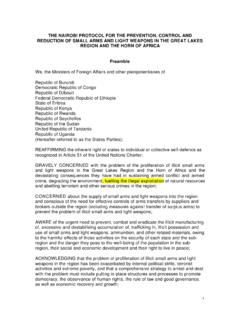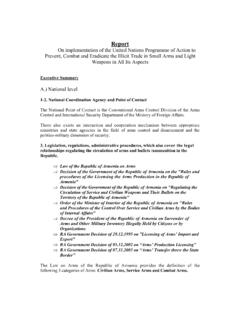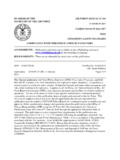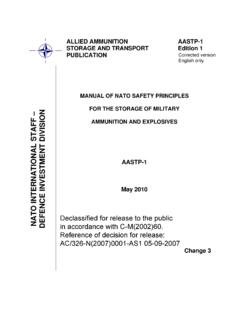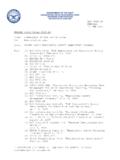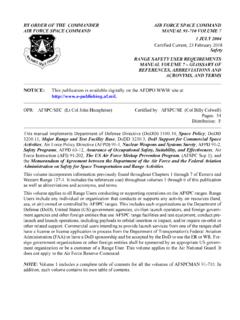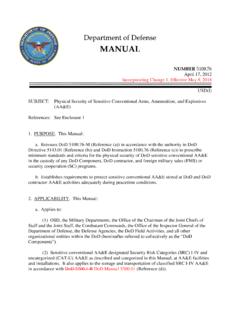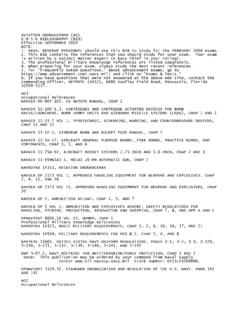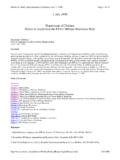Transcription of A Destruction Handbook - poa-iss.org
1 Department for Disarmament AffairsA Destruction Handbook small arms, light weapons, ammunition and explosivesUNITED NATIONS asdfNOTEThe designations employed and the presentation of the materialin this publication do not imply the expression of any opinion whatsoever on the part of the Secretariat of the United Nationsregarding the legal status of any country, territory or area, or of itsauthorities or armed groups, or concerning the delimitations of itsfrontiers or further information please contact:Department for Disarmament Affairs Conventional Arms Branch, S-3170 United NationsNew York, NY 10017 USAE-mail: (212) 963-1121 Also, see DDA website: design by Josie K. Belamide-ZweigCover photo of gun by Pernacca Sudhakaran, UN/DPI_____ iii FOREWORD Jayantha Dhanapala Under-Secretary-General for Disarmament Affairs The worldwide proliferation of small arms, light weapons, ammunition and explosives has exacerbated many civil conflicts in recent years, prolonging such conflicts and contributing to human insecurity on a vast scale.
2 It is particularly tragic that civilians, mainly women and children, have been the primary victims of the misuse of such weapons. Any systematic effort to deal with the menace of small arms proliferation would require the retrieval of such weapons, ammunition and explosives from illicit circulation with the aim of destroying them, so that there is no possibility of their diversion through illegal channels into civilian possession. The Destruction of surplus stocks would also contribute to this objective. The Destruction of small arms and light weapons is essential for post-conflict societies where peace-building efforts have often been hampered by the easy availability and continued misuse of such weapons. Their timely Destruction in such situations will also help to stem the flow of arms and ammunition from one conflict or post-conflict zone to another, which has occurred all too often to the great detriment of regional, sub-regional and national security.
3 Destruction however has to be undertaken under professional guidance with due care to safety and the environment. This booklet is aimed at assisting planners and managers by providing them with a range of possible options, thereby helping them to identify feasible methods in the light of their specific situations and requirements. This publication builds upon the Secretary-General s Report on Methods of Destruction of small arms, light weapons, ammunition and explosives (S/2000/1092) of 15 November 2000. It is an expanded version of that report, drawing upon the material contained therein as well as incorporating additional material, particularly with regard to the Destruction of ammunition and explosives associated with small arms and light weapons.
4 _____ iv This is a first edition, which is to be followed by a more elaborate effort to develop a comprehensive reference manual with the assistance of interested States. Governments offering comments on the structure and content of this publication, as well as providing information that may add value, would facilitate the development of a comprehensive manual. It is my hope that this booklet will prove useful to planners and managers, as well as other interested individuals and groups, who are involved in issues concerning the Destruction of small arms, light weapons, ammunition and explosives . It is also my hope that this publication, which will be distributed widely, will further strengthen international support for the retrieval and Destruction of illicit stocks of arms and ammunition , in addition to surplus stocks.
5 _____ v ACKNOWLEDGEMENT This publication has been made possible in part through a generous grant from the Government of the Netherlands to the Department for Disarmament Affairs. _____ vi Photo courtesy of the UN by Steen Johnson _____ 1 1 2 Background .. 2 Aim .. 3 3 5 2 The Destruction of small arms and light 10 10 Methods of Destruction .. 11 3 Destruction of small arms 25 25 Methods of Destruction .. 26 4 Destruction of rockets, missiles, shells, mortars and grenades .. 43 43 Open-pit Destruction by 43 Safety .. 44 44 Specific ammunition 45 ammunition requiring special treatment.
6 45 Disposal site .. 45 Contained detonation .. 48 Contained burning/deflagration .. 48 5 Destruction of pyrotechnics .. 50 Methods of Destruction .. 50 6 Destruction of 56 56 Methods of destroying bulk high explosives .. 56 Methods of destroying low explosives .. 60 7 Other explosive hazards .. 63 _____ 2 1. Introduction On 24 September 1999, the Security Council convened its first meeting at ministerial level devoted to the issue of small arms. A report (S/2000/1092) was prepared with the assistance of internationally recognized experts following the ministerial meetings request that the Secretary-General develop a reference manual for use in the field on ecologically safe (amended in report S/2000/1092 to read 'environmentally sound') methods of weapons Destruction in order better to enable Member States to ensure the disposal of weapons voluntarily surrendered by civilians or retrieved from former combatants.
7 The report has been used as a guide in the preparation of this aide m moire. This Handbook is seen as the first step in producing a definitive reference manual to be used primarily in post-conflict situations by planners charged with the recovery and Destruction of weapons and ammunition . As recovery programmes are already under way it is thought that the first stage in developing the reference manual should be to offer planners already engaged on recovery programmes with as many Destruction options as possible. Background This Handbook has been prepared for use by planners in the field as an easy reference guide to the various methods that may be employed in the Destruction of small arms and light weapons (SALW) and their associated ammunition natures.
8 It is aimed primarily at post-conflict situations and not at systematic stockpile Destruction of a nation s surplus or unserviceable SALW. To date the principal work in this area has been undertaken by the Bonn International Center for Conversion (BICC), the Monterey Institute of International Studies (MIIS), and the United Nations Development Programme (UNDP)/ Department for Disarmament Affairs Albania Gramsh Pilot Weapons in Exchange for Development Project. Their work served as a primary basis for the S/2000/1092 report. _____ 3 Aim This Handbook is designed to assist planners in the field to choose methods of Destruction that are most appropriate to the theatre of operations they find themselves in. It is not designed to be used as a substitute for the guidance that appropriately qualified and experienced technical experts should provide.
9 It identifies the areas of expertise that will be required by the planning team. In identifying the likely environmental outcome of any course of action, it allows the planning team to weigh the resources available against the urgency and degree of Destruction required in the unique circumstances that surround each project. Scope The weapons covered by this Handbook are those small arms and light weapons, ammunition and explosives as defined in the 1997 report of the Secretary General on small arms prepared with the assistance of the Panel of Governmental Experts on Small Arms. The exception will be landmines, which are, in part, the subject of a separate Destruction protocol developed by UNDP in the context of the Convention on the Prohibition of the Use, Stockpiling, Production and Transfer of Anti-personnel Mines and on Their Destruction , (otherwise known as the Ottawa Convention or the Mine-Ban Convention).
10 The report of the Panel of Governmental Experts (A/52/298, annex, para. 26) contains definitions for the following categories of small arms and light weapons, including ammunition and explosives : Small arms Revolvers and self-loading pistols Rifles and carbines Sub-machine guns Assault rifles Light machine-guns Light weapons Heavy machine-guns Hand-held, under-barrel and mounted grenade launchers Portable anti-aircraft guns Portable anti-tank guns and recoilless rifles Portable launchers of anti-tank missile and rocket systems _____ 4 Portable launchers of anti-aircraft missile systems Mortars of calibres less than 100 mm Photo courtesy of Small Arms Destruction Project [Albania, Germany, Norway and the United States] ammunition and explosives Cartridges (rounds)

